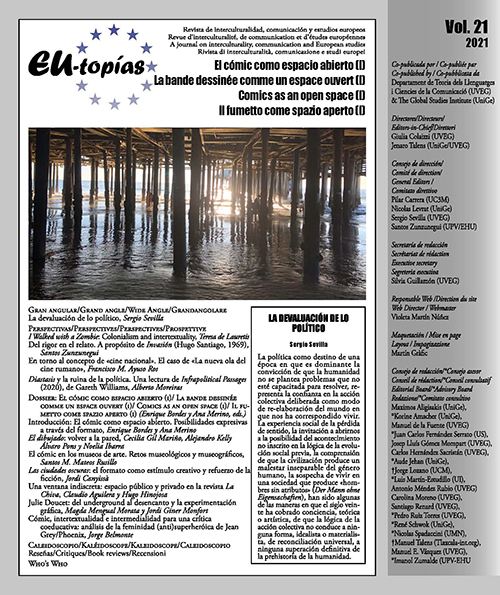Les Cités Obscures : format as creative stimulus and reinforcement of fiction
DOI:
https://doi.org/10.7203/eutopias.21.21268Keywords:
<em>Les Cités Obscures</em>, Schuiten and Peters, European comic. Abstract
Abstract
Since its appearance in 1983, Schuiten’s and Peeters’ Les Cités Obscures has become one of the most stimulating series in contemporary European comics. This article studies the saga in relations with its materiality by examining the multiplicity of formats used by the authors and by pointing to two-tiered implications: sometimes the format determines the content of the fictional work, at other times it is the content that constraints and shapes the format of the fiction. Schuiten and Peeters show that, if support is used skilfully, it is possible to reach new heights of expression. We first analyze how the authors have used the two traditional formats of European comics (magazines and albums) and how the very materiality of the medium has led them to present different versions of the work. Secondly we study how the multiplicity of formats increases with the rising of the authors’ prestige, which allows them to make more challenging creative efforts such as with giant-size albums or illustrated books. Thirdly and lastly, we will point to how the authors’ concern with format ends up exceeding the dimension of the printed page (the comic strip’s traditional form of expression) and spills over to other media: it expands the world of the Cités Obscures in a pioneering website, a DVD, conferences, exhibitions and also some architectural renovations integrating reality as a gateway to the universe of fiction, thus blurring the boundaries between the real and the fictive.
 Downloads
Downloads
 References
References
Atallah, Marc y François Rosset. Mondes imparfaits : autour des Cités obscures de Schuiten et Peeters. Bruselas: Les Impressions Nouvelles, 2019.
Baetens, Jan y Pascal Lefèvre. Pour une lecture moderne de la bande dessinée. Bruselas: Centre Belge de la Bande Dessinée, 1993.
Baetens, Jan. Rebuilding story worlds. The Obscure Cities by Schuiten and Peeters. New Brunswick: Rutgers University Press, 2020.
Bocquet, José-Louis. Dossier de presse. La Théorie du grain de sable. Bruselas: Casterman, 2007.
Ciment, Gilles. «Poche. Le pour et le contre». L’Anné de la Bande Dessinée, 87-88. Grenoble: Glénat, 1988, pp. 98-101.
Duplan, Antoine. «Les Cités obscures, c’est un puzzle, mais un puzzle infini». 14 Dic. 2018. www.letemps.ch/culture/cites-obscures-cest-un-puzzle-un-puzzle-infini
Fromental, Jean Luc. «L’artisan, son père, le faussaire et leurs enfants». Angoulême. Le Catalogue 90, 1990, pp. 40-49.
Grillet, Thierry. «Des Cités à croquer». Les Inrockuptibles, 113, 23 de julio – 5 de agosto de 1997, pp. 20-23.
Jans, M. y J-F. Douvry (dir.) Schuiten & Peeters : autour des Cités Obscures. St-Egreve: Mosquito – Dauphylactère, 1994.
Leroy-Terquem, Mélanie. «“J’ai toujours été favorable à une définition poreuse de la bande dessinée”, entretien avec Benoît Peeters». BNF. Sept. 2019. https://www.bnf.fr/fr/jai-toujours-ete-favorable-une-definition-poreuse-de-la-bande-dessinee-entretien-avec-benoit
Peeters, Benoît. La bande dessinée entre la presse et le livre : fragments d’une histoire. París: Bibliothèque Nationale de France, 2019.
Peeters, Vladimir. «La Fièvre d’Urbicande en couleur, interview de Benoît Peeters, François Schuiten et Jack Durieux». Youtube. 29 Oct. 2020. www.youtube.com/watch?v=fX03koyD_Xo
Schuiten, François y Benoît Peeters. L’aventure des images : de la bande dessinée au multimédia. París: Editions Autrement, 1996.
Smolderen, Thierry. «Conversations avec François Schuiten». Les Cahiers de la Bande Dessinée, 69, mayo-junio 1986, pp. 7-20.
Downloads
Published
How to Cite
-
Abstract445
-
PDF (Español)386
Issue
Section
License
![]()
The authors conserve the copyright. All content published in EU-topías. Journal of interculturality, Communication, and European Studies are subject to the license Creative Commons Attribution-NonCommercial-ShareAlike 4.0 license. The full text of the license can be found at <http://creativecommons.org/licenses/by-nc-sa/4.0>
They may be copied, used, disseminated, transmitted and publicly displayed, provided that:
- The authorship and original source of the publication is cited (journal, publisher and URL of the work).
- They are not used for commercial purposes.
- The existence and specifications of this license of use are mentioned.
It is the responsibility of the authors to obtain the necessary permissions for images that are subject to copyright.



